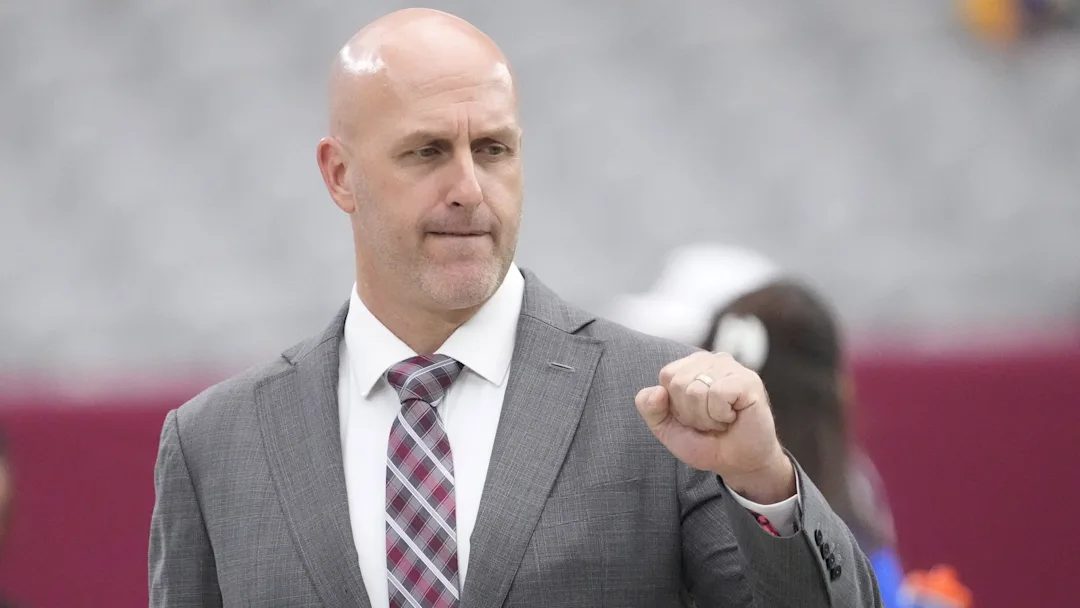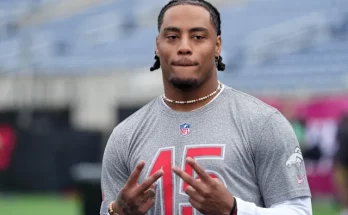In the ever-evolving landscape of the NFL, player movement is inevitable. Teams constantly weigh financial commitment against production, age, and scheme fit. Amidst the flurry of post-draft speculation and free agency rumors, one storyline has begun to simmer involving a former rival of the Arizona Cardinals: a $72 million player who is now available and potentially seeking a new home.
But despite the surface-level intrigue, the Arizona Cardinals should not take the bait. Whether from a cap management perspective, roster-building philosophy, or team identity standpoint, this high-priced veteran simply doesn’t align with Arizona’s long-term vision. Let’s break down why the Cardinals should steer clear of this former NFC West foe.
Who Is the $72 Million Former Rival?
The player in question is none other than Leonard Floyd, former Los Angeles Rams pass rusher and most recently a high-paid edge defender with the Buffalo Bills. After signing a 4-year, $64 million extension with Los Angeles and earning more through incentives and guarantees, Floyd eventually joined Buffalo in 2023. Despite a strong statistical season, Floyd was released in a cap-saving move this offseason.
Given his history of tormenting the Cardinals twice a year during his Rams tenure, Floyd’s name has surfaced in speculative articles about reunions within the NFC West, or possible vengeance-fueled signings by division rivals.
But should the Cardinals—who are clearly rebuilding and focusing on youth—bite? Let’s examine the reasons they absolutely should not.
1. Age Doesn’t Align with Arizona’s Timeline
Leonard Floyd turns 32 this September. While he’s still productive (10.5 sacks with Buffalo in 2023), the Cardinals are not one edge rusher away from contending. Arizona is firmly in year two of a total franchise overhaul under head coach Jonathan Gannon and general manager Monti Ossenfort. They’re loading up on draft capital and prioritizing development over desperation.
Signing a 32-year-old to a short-term deal would be a classic win-now move. But Arizona isn’t there yet. Even if Floyd provides one good season, it doesn’t move the needle toward sustained playoff contention. In fact, it might detract from the reps and snaps needed by younger defenders like BJ Ojulari and rookie Darius Robinson.
The timeline simply doesn’t match. Floyd needs a contender. The Cardinals are still building one.
2. A Heavy Price Tag for a Cap-Conscious Team
Although Floyd likely won’t command another $72 million deal, he won’t come cheap. Spotrac estimates his market value near $10–12 million per year, given his consistency as a pass rusher. With Arizona carrying multiple dead cap hits and preparing for Kyler Murray’s contract to fully mature, the team must be cautious with mid-tier veteran investments.
Arizona also extended key homegrown talents like tackle D.J. Humphries (before his release due to injury) and safety Budda Baker. Ossenfort’s roster philosophy leans toward internal development over outside spending sprees. Floyd’s signing would go against the grain.
Moreover, the Cardinals used a first-round pick on Darius Robinson and are developing Ojulari on the edge. Floyd’s presence would require either overpaying for a rotational role or misallocating developmental snaps. Neither is ideal.
3. Redundancy at a Non-Premium Position (For Arizona)
Yes, pass rush is critical in today’s NFL. But for Arizona, linebacker/edge has already received significant draft and roster investment. Between Ojulari, Zaven Collins (transitioning from inside linebacker to the edge), Victor Dimukeje, and now Robinson, the Cardinals have a crowded but ascending group.
Floyd, while skilled, doesn’t dramatically shift the dynamic. He’s not an elite game-wrecker like Myles Garrett or Micah Parsons. He’s a steady contributor—reliable, not revolutionary. And the Cardinals, with many holes across the roster (especially in the secondary and offensive line depth), cannot afford luxury pieces at already addressed positions.
Rather than spend $10 million per year on a pass rusher who won’t alter the team’s trajectory, Arizona should reinvest that money in the trenches or bolster the cornerback unit—two areas far more needy.
4. Blocking Development of Young Talent
Arizona’s 2024 draft class was headlined by wide receiver Marvin Harrison Jr., but the team also spent major draft capital on front-seven help, including Missouri’s Darius Robinson (No. 27 overall). Robinson is a physical force with versatility to play inside or rush off the edge. The coaching staff envisions him as a high-motor, three-down contributor from day one.
Adding Floyd to the mix creates an immediate snap-count conflict. You don’t draft someone in the first round to sit behind a veteran on a one-year deal. Similarly, Ojulari, entering his second season, deserves extended opportunities to develop. Defensive coordinator Nick Rallis needs a clean evaluation process—not a clogged depth chart.
The best way to prepare these young pass rushers is by playing them. Floyd’s presence would only create confusion, misalignment, and a rotation dictated by contract rather than performance.
5. Floyd’s Production Is Inflated by Scheme and Supporting Cast
There’s no doubt Leonard Floyd has been productive. He posted 29 sacks in three years with the Rams and added another 10.5 with the Bills. But context matters.
In Los Angeles, Floyd benefitted from playing next to Aaron Donald, one of the most disruptive interior linemen in NFL history. Quarterbacks were often flushed directly into Floyd’s lane, where he cleaned up plays. In Buffalo, Floyd lined up alongside Von Miller and Ed Oliver—again, within a loaded front.
Arizona’s defensive line, while promising, doesn’t yet feature a Donald-level force. Robinson may become one, and Dante Stills shows potential, but neither currently command double-teams. Floyd would likely be less effective without elite complementary talent absorbing blockers.
Spending big on a player who thrives in an ecosystem that Arizona doesn’t yet have is not just risky—it’s financially irresponsible.
6. Culture and Identity Conflict
Jonathan Gannon and Monti Ossenfort are clearly shaping the team around toughness, effort, and internal growth. Gannon’s defense relies on discipline, communication, and development rather than star-chasing.
Floyd, while a consummate professional, represents a different era and ethos—one shaped by big-money signings and superteam vibes in L.A. That kind of identity may not translate to a rebuilding team looking to grow its own culture from within.
Furthermore, Floyd has been part of winning franchises (Rams, Bills) and may not respond well to a transitional phase where the team is learning how to win. It’s unfair to insert him into that kind of situation and expect instant results or full buy-in.
Arizona needs veterans who can mentor and relate to its youth movement. Signing a win-now mercenary, even a productive one, doesn’t help establish the locker room culture Gannon is striving to build.
7. Opportunity Cost: Better Ways to Spend
Every dollar matters in today’s NFL. Signing Floyd would eat up resources that could be spent elsewhere:
- Cornerback depth: Still a major concern for Arizona, especially with injury history at the position.
- Interior O-Line: Kyler Murray needs protection, and the center/guard spots could still use upgrades.
- Wide receiver No. 2/3 roles: Behind Harrison Jr., there’s a mix of unproven talent. A savvy vet WR might help more than another edge rusher.
- Safety help: Budda Baker is an anchor, but depth is shallow.
In short, the Cardinals have real needs. Edge rusher isn’t one of them anymore, especially not at the price and profile of Leonard Floyd.
Final Verdict: Tempting, But Misguided
Leonard Floyd will likely find a new home soon—perhaps with a contender like the Ravens or Chiefs, where he can chase a Super Bowl and complement an established pass rush. That’s the role he’s suited for now.
The Arizona Cardinals, meanwhile, must stay the course. They are not one Floyd away from playoff relevance. Their identity is being shaped by rookies and second-year players hungry to prove themselves. Their dollars should go to developmental building blocks—not aging mercenaries.
Fans might recall Floyd’s game-wrecking performances against Arizona and see value in the revenge narrative. But nostalgia is a poor guide for roster construction. This is a new era of Cardinals football. The mistakes of past regimes—overspending on veterans without a clear plan—must not be repeated.



